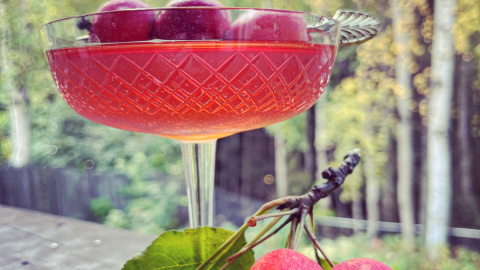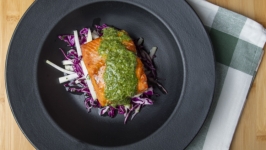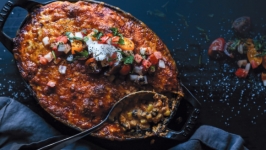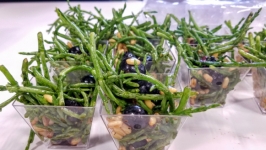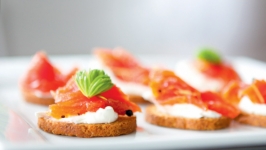Expanding the Wheelhouse
Editors’ note: Sarah Reynolds Westin’s work on this article was made possible by an artist in residency program housed in the Alaska Division of Parks and Outdoor Recreation (Alaska State Parks), and supported, in part, by a grant from the Alaska State Council on the Arts and the National Endowment for the Arts, with additional support from Rasmuson Foundation.
“Hey, are you that reporter who didn’t call me back?”
The question comes from above. My mind quips, You mean writer? I know who’s speaking and what he’s getting at, so I stop. In a protected harbor with boats surrounding me, I’ve walked down a ramp to a dock on Near Island, right across from the town of Kodiak, Alaska. A smiling bald man leans out a bridge—the word skippers use interchangeably with wheelhouse to refer to the area where the boat driver works.
“Dave,” I say, elongating his name, “you caught me, I’m sorry! My plane was delayed. By the time we landed, my kiddo needed to eat and stretch his legs.”
Dave Kubiak laughs. “I’m just kidding.” He’s been a Kodiak resident for almost 60 years and fishing as long. Leaders from the Alaska Marine Conservation Council introduced me to him and other fishermen before I travelled here. “Where you headed now?”
I tell him I’m going to meet Rob Carter, another Kodiak-based fisherman.
“How about swinging by when you’re done?”
I smile, giving Dave a thumb’s up.
A few moments later, I stand near the end of the dock, trying to intuit which boat Carter owns. I pull out my iPhone to check his instructions, but a seagull lures me away when it cries overhead, disrupting the calm, quiet bay. Eying my surroundings to find the bird, a blue fishing boat, Faith, catches my attention. The name seems like a harbinger. I take its picture, forgetting to check Rob’s message, and walk alongside it. A man is welding bars.
“Excuse me, do you know where I can find Rob?”
“You’ve found him,” he says. “You must be Sarah. Wanna climb aboard?” The cadence of his voice is like a slow tide, steadily rolling into a shallow bay.
I recap what I’m doing on Kodiak, which is trying to understand how the community protects and sets quotas for its fisheries and how their decisions impact the local workforce and marine life. “I’m starting with you, Rob,” I say, concluding my spiel by adding, “I’ll take notes and ask questions as you go. So… when did you begin fishing?”
From 1987 until 2020, Rob alternated between crewing for others and running his own small operations. “My big break came in 2007,” he says, noting the price per pound of halibut skyrocketed. “My crew share helped me buy Faith.” The boat was better for longlining and jigging cod. Then cod crashed, and Rob realized, “It’s either be an old, broken-body crewman or position myself to survive fishing my own boat.” So he worked to secure permits for salmon and Tanner crab, quitting crewing in 2020 and bringing us to present day. “We,” he lilts, referring to Kodiak as a whole, “just wrapped up our biggest season in decades.” Pausing, Rob clarifies, “For Tanner crab… almost 6 million pounds.”
According to the most recent Fisheries of the United States report, produced by the National Oceanic and Atmospheric Administration (NOAA) Fisheries, Kodiak ranks third in volume and sixth in value of seafood landed in the U.S. Based on its 2023 harvest, those rankings may increase, which might surprise people following the collapse of the king and snow crab harvests. In any case, for wildlife and marine harvests in Alaska to occur—whether on the land or in the sea—the Alaska Department of Fish and Game (ADF&G) must make estimations and predictions about populations and then set limits. For Tanner crabs, at least 400,000 pounds of mature crabs must exist in the Kodiak archipelago to open the commercial fishery. Furthermore, plenty of “recruits,” the term used to reference juvenile crabs, must be available to ensure future seasons exist. So, while the king and snow crab stocks crashed in nearby areas, apparently Tanner crab thrived, leaving people wondering, What crash comes next and where?
Recent years have reminded everyone that stock assessments and quotas rely on variables that researchers, advocates, and policymakers can’t control. Consider warming waters, ocean acidification, aquatic food webs, consumer trends, and interest rates—to name a few. Changes can be made to improve the assessments, but time is required before benefits are realized. Even then, no one can deter natural forces. For people on Kodiak, like Rob, trying to understand these broad and converging variables and their immediate and long-term effects is essential.
Rob considers himself lucky to have gotten his permit for Tanner crabs, which limits fishermen to 20 pots and equalizes the playing field. To make the most of it, Rob is switching his pyramid pots to square ones—the task that he was working on when I arrived. They hold more, which means Rob can catch more.
“Here’s the crazy thing,” he says with a tone of resignation. “While our catches are getting bigger, we’re making less money.” Increased catches yet decreased prices hold true for Tanner crabs, cod, and salmon too—truthfully for almost every seafood catch in Alaska. “Most people wouldn’t know it since supermarket prices are high.”
Between king and snow crab harvests being cancelled and ostensibly irreconcilable price factors in the seafood industry, everything seems amiss. Leaving Faith, I head over to Dave, hoping he’ll have answers.
He invites me to his wheelhouse as a reprieve from the cool, damp air. My initial impression of Dave proves accurate: he has an easy way about him, and I feel comfortable.
Dave makes coffee while I retrieve my notebook and snap pictures.
For about 15 minutes, Dave and I swap stories about our children and make jokes about what brought us to Alaska. Our chit-chat makes the rest of our conversation more like picking a long-lost friend’s brain, rather than interviewing a stranger.
Dave’s father was transferred from Maryland to the United States Coast Guard station in Kodiak. “When I came here in ’64, I was devastated to leave behind my shorts and flip-flops,” he recalls, noting he was 15 years old. Kodiak was reeling from the Good Friday earthquake and tsunami, and the island seemed like a different world. “Man, back in Baltimore, one inch of snow was a disaster.”
That move helped carve Dave’s path. Soon after arriving, he met Oliver Holm, who became his close friend, and Kristine Harder, who became his crush. They unwittingly anchored Dave to Kodiak. As his first summer in Kodiak approached, Kristine’s dad had a question for him, Are you gonna go chasing my daughter around town or go out fishing with us? Dave asks me what I think he chose.
Without hesitation, I say, “Fishing.”
“Bingo, and Kristine stopped talking to me.” We both chuckle.
Although Dave sunk his relationship, he spawned a connection with fishing. It started with him working setnets with her father at Cape Ugat. The next spring, Dave set fish traps for herring in Gibson Cove with Oliver and his dad. In both instances, he was along for the ride— not the pay. Once he graduated from high school, Dave went to college to study biology and English. Soon, he was back in Kodiak, newly married, establishing his family and high school teaching career and resuming friendships and fishing.
“One summer—1981, I think—Oliver’s crewman called, begging me to go out with them because they’d lost their skiff man.” Dave took his pre-teen son with them and unrolled tarps on the deck for him to rest. “I’d never made a dime fishing before, but this trip made it clear I could and had what it takes…minus a boat.”
Oliver, who was replacing his boat Phoenix, helped Dave fix that problem. “He sold it to me for $15,000,” he says, “with only 10 percent down and the rest paid off at 10 percent a year without interest.” Dave gets up from the pilot’s seat and shows me old pictures saved to his iPhone.
Buying Phoenix allowed Dave to start fishing when school was out. Along with the herring already mentioned, over the years, he has commercially caught pollock, cod, halibut, and salmon along with Dungeness and Tanner crab. Part of Dave’s diverse catch comes from enjoying being on the water. Another part comes from needing to expand his abilities to stay braced in a fluctuating seafood industry with shifting ecological conditions. Now, Dave’s retired from teaching—but he’s still out fishing.
Back at the skipper’s wheel, Dave explains, “No one really understands what’s happening. We have ideas. We have guesses.” He has become ardent, reflecting on anecdotal perspectives and the fleeting nature of life, like he’s behind a lectern in his former classroom, trying to instill a passion in his students for the topic at hand. Like Rob did, he says, “Look, I was lucky.” Dave continues, “I could supplement my teaching income with fishing summers, but you know who you should talk to? Oliver. He has made his entire living off fishing.”
When I knock on Oliver’s front door and see inside, his home feels cozy, exuding warmth with happy memories lingering. He welcomes me in, pointing me to his living room. I let two furry dogs lick my hand while I glance out large windows, which face gray skies and the brooding ocean. Oliver settles into his chair, listing permits and licenses for Tanner and king crab, halibut, and roe herring. Then he drops some local history.
“Since the 1900s, there’ve been lots of ups and downs,” he says. The changes in the industry explain his impetus for diversifying his operations since, according to him, his production counted as relatively small—and his desire to keep it that way.
“Salmon’s been moderately stable since the 1980s. At times, their production’s been depressed because of cold winters,” he continues. “When we’ve had wet winters, salmon fisheries have different problems.”
“As for the other fisheries—the salt cod, the king and Dungeness crab, the freezer plant for halibut on Shuyak Island, and the three herring reduction plants in Raspberry Straits?” Oliver pauses for effect—or to let me get it all down. “They’re all gone now.”
While fisheries management and science has evolved since the 1970s, fisheries continue collapsing in Kodiak and other places—sometimes for a while and other times indefinitely. NOAA Fisheries and ADF&G coordinate to regulate Alaska’s fishing and processing quotas to try to help ensure fisheries’ and stocks’ longevity and prevent severe fluctuations to the seafood industry. However, contradictory information about stocks circulates.
“It took a toll on fishermen,” Oliver says, thinking back on the cod crash, “but fewer cod actually helped grow the Tanner crab population.” I think, Is that a good thing?, and recall Dave and Rob mentioning something along these lines too, using an expression—“kissing the bottom”—that I needed defined. It means trawlers crushing crabs. A pretty bleak image. So, when the cod fisheries collapsed, crabs began thriving. No wonder the 1978 and 2018 reports about Tanner crabs in the Kodiak area reflect huge population increases. The number of Tanner crab recruits went from 76.4 million in 1978 to an average of 214M between 1982 and 2018 and landed at 662.4M in 2018.
“You hear doom and gloom about oceans and fisheries, but they’re actually quite productive,” Oliver says.
Like many people in Kodiak, he’s altered course. His wife, Eva, who has joined us, chimes in, “There’s always something there for fishermen. We just adapt.” She rolls her shoulders, leans back in her seat, and interlaces her fingers on her lap. “We’re lucky to be in a place with so many fisheries around.”
Part of me can see that they are lucky—a word that has popped up often. Another part wonders if this sentiment has become a community talking point. Every Kodiak resident insists their waters have a rare convergence of resources. They recognize the fluid bounties and find many ways to adapt to changes. These factors—along with optimism—appear to be what propels them, despite their facing unpredictable variables and inconsistent fisheries.
W. Jeffrey Bolster, author of The Mortal Sea, suggests humans interact with the oceans as if they cannot affect them, treating them as “infinite and overwhelming.” People—whether fishermen, scientists, or managers—aren’t to blame, Bolster concludes. The system is to blame. It tolerates destabilization for short-term gains.
As Oliver and Eva banter back and forth, reminiscing about fishing, I watch and listen, soaking in their interactions and letting my thoughts whirl. I came to Kodiak concerned I’d discover dwindling populations—both human and marine. While I did, fortunately that’s not the whole picture since I also found resilient people tackling challenges, charting courses, and riding currents.










